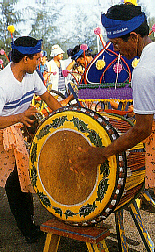Malaysia is a multi-cultural nation with a fascinating potpourri
of Malay, Chinese, Indian, Peranakan (Straits Chinese), Eurasian,
Kadazan, Iban, Bidayuh, Dayak and indigenous Orang Asli peoples.
MALAY CUSTOMS
The Malays are a race known for its rich traditional values and
habits. Visitors to a Malay household are treated with respect
as a token of hospitality. Light snacks and drinks will be offered
and to refuse them would be impolite. In the olden days, hosts
are expected to offer sekapur sireh (a preparation of sireh leaves
stored in a box to be eaten with a thin layer of slaked lime, gambier
and slices of the areca nut. Today this custom is only practised
by those living in the villages. Visitors are also expected to
dress decently and be well-mannered when visiting.
The Malays do not take pork or alcohol. It is forbidden in their
religion, Islam. Preparation of meals for Malays must be halal,
that is according to the Muslim law. Most Malays still prefer eating
with their hands. For the Malay guests, a finger bowl is a must
when serving. Be sure you do not drink it, it is for washing the hands.
 The giant drum or Rebana Ubi in Malay is a favourite among the locals in the east coast. These drums are used during wedding ceremonies and recreational competitions.
The giant drum or Rebana Ubi in Malay is a favourite among the locals in the east coast. These drums are used during wedding ceremonies and recreational competitions.
It is made from a hollowed-out log about 0.6m in diameter, weighs about 108 kg and is 0.53m from head to base. The drum head is 0.9m and the base diameter is 0.675m. During a competition, the drums are assembled in groups of six
with two players to a drum. The players will normally dress in
colorful traditional costumes complete with headgear and sashes.

The waus or giant kites are also from the east coast. They are used as decorative pieces or in competitions. They come in all shapes and sizes but in the state of Kelantan, they make their kites to stay as close to the traditional patterns as possible. The kites are hand-drawn and are decorated with colorful paper and strands of thread. Sometimes a bow-shaped device is attached to the kite to give it a high pitched humming sound when flown. It takes weeks to make and decorate a kite.
The most popular wau is the Wau Bulan or Moon Kite, named
because its tail resembles a cresent moon. Our Malaysian Airlines has adopted the wau bulan as its logo.
Take a look at some of the traditional houses of the Malays and the surroundings. It is quite interesting to look at the Malay architecture.
Here are also some interesting local scenes of Malaysia. The top left of the picture shows a Kelantanese woman selling fruits. In Kelantan, the womenfolk dominate the scene at the local market. The picture on the top right is an evening market in Klang, Selangor. At the bottom left, is a picture of the weekly "tamu" or gather of natives of Kota Belud in Sabah. Finally, at the bottom right, the famous Chinatown night market of Petaling Street in Kuala Lumpur.
Thaipusam is a Hindu festival full of color and mystery. It is
an occasion for Hindu Devotees to pay homage to Lord Murugan by
piercing their bodies with sharp objects and carrying "kavadis"
bearing the image of Lord Murugan. Before one is able to carry the kavadis, they must go through a fasting period.
Another unique culture in Malaysia is the Peranakan Culture. Here, you will see the Chinese dressed up more like Malays than
Chinese. They are called the Babas and Nyonyas. Find out more about this unique culture here.
I have just started this page, so visit again soon if you want to see more pictures and know more about Malaysia. You will not be disappointed.

 The giant drum or Rebana Ubi in Malay is a favourite among the locals in the east coast. These drums are used during wedding ceremonies and recreational competitions.
The giant drum or Rebana Ubi in Malay is a favourite among the locals in the east coast. These drums are used during wedding ceremonies and recreational competitions.

 Links
Links
 Back to Homepage
Back to Homepage
 Back to Malaysia page
Back to Malaysia page
![]()
![]() Get your own Free Home Page
Get your own Free Home Page